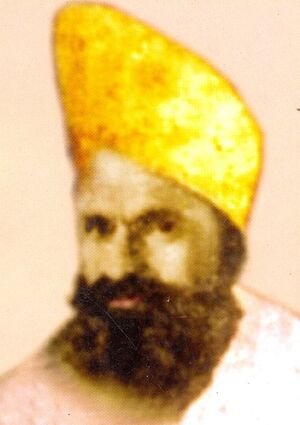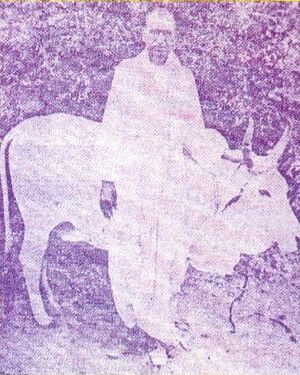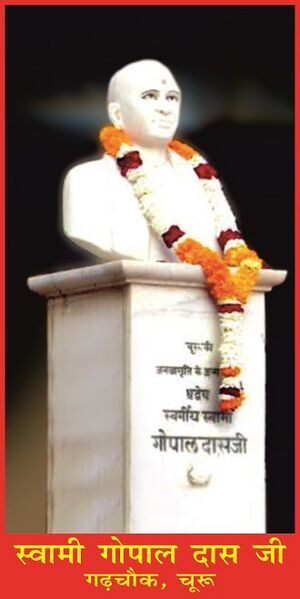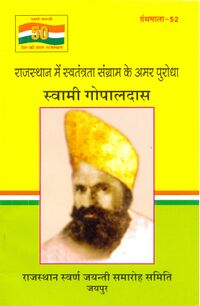Swami Gopal Das
| Author:Laxman Burdak, IFS (Retd.), Jaipur |
Swami Gopal Das (स्वामी गोपाल दास) (1882-1938) was a social worker, educationist and freedom fighter from Churu in Rajasthan state in India.
Contents
- 1 Childhood
- 2 Came to Churu
- 3 Committed to the welfare of cows
- 4 An environmentalist
- 5 Social Services
- 6 Public awakening
- 7 Woman education
- 8 Freedom fighter
- 9 स्वामी गोपाल दास का जीवन परिचय
- 10 सम्मान
- 11 स्वामी गोपाल दास पुरस्कार
- 12 राजस्थान में नव चेतना के चितेरे और आधुनिक चूरू की चमक
- 13 Gallery
- 14 Further reading
- 15 Reference
Childhood
He was born in 1882 in village Bhainrusar situated at a distance of 13 km north of Churu town in Rajasthan in the family of Chaudhary Binja Ram Kaswan and Smt Nauji Devi. He lost his father in his childhood. There was no source of livelihood for her mother so she went to Churu with Gopal and took up labour work to make both end meet.
Came to Churu
Mahant Mukund Das of ‘Chhote Temple’ in Churu provided some support to her mother. Nauja Devi handed over her son Gopal to Mahant Mukund Das, who was impressed by the intelligence of child and sent him to a school run by Pandit Kanhaya Lal Dhandh. Sharp and intelligent Gopal Das learnt the lesson of humanity from his Guru and also obtained knowledge of Ayurvedic treatment. In view of the talent of Gopal, Mahant Mukund Das declared him as his disciple. After the death of Mahant Mukund Das, the 19-year Gopal was made the Mahanta of Nimbarka Sampradaya in his place and became Swami Gopal Das. The personality of Swami Gopal Das was very impressive. He was tall, handsome, with well built physique and broad headed and wore khadi dhoti-kurta and turban.
Committed to the welfare of cows
He was all his life committed to the welfare of cow as he considered cow to be an essential part of Indian life and culture. During the famine years Gopal Das arranged fodder and water for cows to lessen their sufferings. There was a ‘pinjarapol’ (Goshala) in Churu, which was at the verge of closure due to insufficient funds in those days. Gopal Das started a fair on ‘Gopashtami’ at this ‘pinjarapol’ and gave new life to it. The fair is still organized every year.
An environmentalist
He took large chunks of wasteland from the rich Seths of Churu and developed these as pasturelands for grazing of cows and did extensive plantations over them. These pasturelands and plantations not only saved the cows but also stopped further expansion of desert. The nearby villagers also were motivated from these acts and they also developed pasturelands in their villages.
Love for tree plantation was there in Swami from childhood as is clear from his letter written from Sardarshar to Shri Gigdas to take care of the Pipal tree he had planted in his childhood. It was due to his efforts that trees covered the deserted sand dunes. The big trees on both sides of the road from Railway Station to Ram temple in Churu town are there as a result of his hard work as he watered them by carrying water over his own head.
Social Services
Swami Gopal Das was a committed social worker. In 1917-18 Churu was infected by epidemic of plague and malaria. People died in large number. Rest of the people started running out leaving the weak and ill people behind. The town was deserted. The left out people started dying due to no care. There were no people left to even lift the dead persons. At this juncture Swami Gopal Das came to help the left out people by providing food, water and medicines and arranged to lift dead persons for cremation. It became difficult to move around on foot to look after the people so he took a horse and started taking round of the town. The famous poet from Churu Pandit Amolak Chand has written following poetry on the services of Swami Gopal Das in Rajasthani language as under:
- "चूरु शहर में सोर भयो, जद जोर करयो पलेग महामारी ।
- लाश पड़ी घर के अन्दर ढक छोड़ चले बंद किवाड़ी ।।
- आवत है गोपाल अश्व चढ देखत जहाँ बीमार पड्यो है ।
- देत दवा वो दया करके नाथ, अनाथ को नाथ खड्यो है ।।"
The epidemic was so severe that Post and Telegraph services collapsed. Swami Gopal Das arranged the delivery of letters and telegrams to the concerned people. His knowledge of Ayurveda proved a boon at this crisis. With his initiatives and efforts the Ayurveda Vidyapith centers started functioning in Churu.
Public awakening
The social services by Swami Gopal Das were multi dimensional. The Churu area prior to independence was suffering from illiteracy, poverty, famines, and lack of medical facilities. The people were exploited not only by British Raj but also by local Jagirdars. To talk about independence or read a new paper in those days was considered a disloyalty to the crown. Under such circumstances Swami Gopal Das started ‘Sarvahitkarini Sabha’ in 1907. The objectives of the Sabha were: satya, ahinsa, asteya and brahmcharya. For the first three years he was Chairman of the Sabha and thereafter its Minister. The Jagirdars were not happy with the foundation of ‘Sarvahitkarini Sabha’ as a result he had to face a lot of opposition from them. There was no building of ‘Sarvahitkarini Sabha’. So he vowed that he would not take food till the Sabha had its own building. He collected money from various sources for the construction of a building of the Sabha and survived on fruits only till seven-storied building was ready for the Sabha. He took a number of steps to improve the conditions of downtrodden people. To remove untouchability from society, he started ‘Kabir Pathshala’.
Woman education
Swami Gopal Das believed that woman’s education was a first step in the development of society and nation. To spread woman education, first of all, he started a ‘sarvahitkaruni putri pathshala’. This institute provided free textbooks to women and also trained them in sewing – weaving so that they can get earnings. This institute provided education to widows also to improve their condition. Later the branches of ‘putri pathshalas’ were started in neighbouring villages and towns. Taranagar putri pathshala was run by Churu sabha itself.
These initiatives taken by Swami Gopal Das in Rajasthan at a time when even Mahatma Gandhi was not on seen are considered revolutionary. ‘Putri pathshala’ and ‘Kabir pathshala’ were considered antireligious activities at that time. On the establishment of putri pathshala, the backward and conservative public had done stone throwing on Swami Gopal Das, but he moved with firmness and was successful in his mission. Swami Gopal Das raised a voice for compulsory education in Bikaner princely state. The ‘sarvahitakarini sabha’ in his guidance run a number of libraries, ‘putripathshala’, ‘Kabir pathshala’, ‘uddyog vardhini sabha’, aturalaya and mahilashrama. In addition there were number of constructive activities like shilpshala, sevasadan, anathalaya, goshala etc.
To eradicate social evils sarvahitakarini sabha also took steps like ban on child marriages and old age marriages, ban on use of toxic materials, spread of Hindi and Sanskrit languages etc. Swami Gopal Das through, sarvahitakarini sabha, also took steps to construct wells, kundas, johars, ponds and renovate old wells and ponds. The works done by sarvahitakarini sabha during famines and epidemics are a landmark in the history of Churu.
The rich Seths of area were very influenced by the honesty and sincerity of Swami Gopal Das. They were ready to provide finances through him. The public park ‘Indramani Park’ in Churu was established through his efforts. Industrialist J.K.Birla on the initiatives of Swami Gopal Das established the ‘Dharmastupa’ in Churu. The statues of Krishna, Mahavira and Buddha on this stupa indicate the faith in all religions. Sarvahitakarini sabha did not differentiate between Hindu, Muslim, Sikh, Baudh and Jain.
Freedom fighter
Swami Gopal Das started freedom movement in Churu. He wrote a series of articles in various magazines on the need of eradication of social evils and demand for freedom from the British. He invited national leaders of freedom movement and arranged their lectures and meetings in Churu. He started placing photographs of Bal Gangadhar Tilak and Mahatma Gandhi in public conferences and preached the use of swadeshi. The activities of Swami Gopal Das frightened the princely ruler of Bikaner, who got lodged case of 'Rajadroha' against him in 1932 and arrested. He was kept in Bikaner Central Jail for three years. Due to his active involvement in the freedom movement he was elected member of Provincial Congress Committee.
Born in a poor family he had become so revered that the millionaires used to touch his feet. He selflessly remained busy throughout his life in the service of the public. He passed away in the month of magha on the banks of river Ganga on magh krishna 3, 1938.
स्वामी गोपाल दास का जीवन परिचय
स्वामी गोपालदास का जन्म चूरू तहसील के उत्तर दिशा में 13 की.मी. दूर एक गाँव भैरुंसर में सन 1882 ई. को चौधरी बीजाराम के घर माता नौजादेवी की कोख से हुआ. अल्पायु में ही इनके पिता का स्वर्गवास हो गया. माता बालक को लेकर चूरू आ गयी और मेहनत-मजदूरी कर बालक का लालन-पालन करने लगी. [1]
चूरू के छोटे मंदिर के महन्त मुकुंददास के आश्रम में माता बालक को छोड़कर अपनी मेहनत-मजदूरी के लिए निकल जाती. बालक की प्रतिभा महन्त जी ने पहचानी और उसकी शिक्षा के लिए उन्होंने चूरू के विद्वान पंडित कन्हैया लाल ढंढ की पाठशाला में व्यवस्था कर दी. बालक ने अनुपम कुशाग्रता का परिचय देते हुए धर्म, दर्शन और आयुर्वेद का विधिवत और गहन अध्ययन किया. बालक गोपालदास में छिपी अध्यात्मिक गहरी और नेतृत्व क्षमता को देखते हुए महन्त मुकुंद दस ने उन्हें अपने पटशिष्य के रूप में मनोनीत किया. इस आशय से उनका नाम सन 1894 ई. में बही-भाटों के आलेख में अंकित करा दिया. सन 1901 में महन्त मुकुंद दास के स्वर्गवास के बाद उनको मंदिर के महन्त के रूप में पदासीन किया. चूरू के मोहता गुवाल सिंह लखोटिया द्वारा 17 वीं सदी में निर्मित इस मंदिर में कुछ काल बाद निम्बार्क सम्प्रदाय की गद्दी स्थापित हुई. कालांतर में बड़े मंदिर का निर्माण हुआ. [2]
जन जागृति के कर्ण धार: जनता में चेतना और जागृति लाने के लिए उन्होंने एक कर्णधार की तरह काम किया. इस हेतु उन्होंने देश के प्रखर नेताओं को चूरू में आमंत्रित कर, उनके व्याख्यानों का सर्वहितकारिणी सभा के मंच से संयोजन कर और देश-गौरव की हर तिथि का सामूहिक उत्सव मनाकर, स्वयं ने खद्दर और सम्पूर्ण रूप से स्वदेशी वस्तुओं के प्रयोग के माध्यम से अनुशीलन की प्रेरणा फैलाई. सर्वहितकारिणी सभा क्रमश: 'चूरू की कांग्रेस' के नाम से जानी जाने लगी. जब उन्हें 'बीकानेर षड्यंत्र काण्ड' में आरोपित कर सन 1932 में बंदी बनाया गया तो देशव्यापी प्रतिक्रिया हुई और देश के बहुत से नगरों में 'बीकानेर विरोध दिवस' मनाया गया. गांधीजी और नेहरूजी ने भी बीकानेर राज्य के इस वैमनस्यपूर्ण कार्य की आलोचना की. [3]
स्वर्गवास: मात्र 57 साल की तप:पूर्ण आयु पूरी कर वे शांतचित्त साधक की भांति सुरेश्वरी गंगा के लक्ष्मण झूला तट पर माघ कृष्ण 3 , वि.सं. 1995 तदनुसार सन 1938 ई. के दिन महाप्रयाण किया. [4]
सम्मान
स्वामी गोपाल दास का जीवन परिचय देने वाली पुस्तक का अभाव था. यह कार्य पूर्ण किया है लेखक प्रेम मोहन लखोटिया ने वर्ष 2003 में. राजस्थान स्वर्ण जयंती प्रकाशन समिति जयपुर के लिए राजस्थान हिंदी ग्रन्थ अकादमी जयपुर ने 'राजस्थान में स्वतंत्रता संग्राम के अमर पुरोधा' पुस्तक माला में अमर स्वाधीनता सेनानी कुंवर नेतराम सिंह गौरीर के व्यक्तित्व एवं कृतित्व पर प्रकाश डाला गया है. [5]
चूरू नगरपालिका द्वारा लोक नायक श्री जयप्रकाश व्यास के कर कमलों द्वारा 17 अगस्त 1956 के दिन सभा और किले के बीच वाले चौक का नामकरण 'गोपाल चौक' किया गया और वहां स्वामी गोपाल दास की संगमरमर की अभिराम मूर्ति स्थापित की गयी जो न केवल चूरुवासियों के गौरव की धरोहर है अपितु यह सम्पूर्ण राजस्थान को अपने गौरवपूर्ण इतिहास और स्वर्णिम भविष्य की प्रेरणा से प्रभासित करती रहेगी. [6]
आपकी सेवाएँ किसानों के हितों के लिए सदैव स्वर्णाक्षरों में लिखी जाएगी और चूरू और आस-पास के क्षेत्र में आगे आने वाली पीढियां सदैव आपकी आभारी रहेंगी.
स्वामी गोपाल दास पुरस्कार
स्वामी गोपाल दास के सम्मान में एक पुरस्कार प्रतिवर्ष दिया जाने का निर्णय लिया गया है. 9 जनवरी 2019 को उनकी याद में चुरू में आयोजित समारोह में प्रथम पुरस्कार चुरू के इतिहासकार स्वर्गीय गोविंद अग्रवाल को मरणोपरांत दिया गया.
राजस्थान में नव चेतना के चितेरे और आधुनिक चूरू की चमक
लेखक: प्रोफेसर हनुमानाराम ईसराण का इस विषयक लेख यहाँ पढ़ें - Rajasthan Me Navchetana Ke Chitere Aur Adhunik Churu Ki Chamak
Gallery
Further reading
- Dr Mahendra Singh Arya, Dharmpal Singh Dudi, Kishan Singh Faujdar & Vijendra Singh Narwar: Ādhunik Jat Itihas (The modern history of Jats), Agra 1998
- Parvati Chaudhary: Jat Samaj monthly magazine, Agra, October 1997
Reference
- ↑ प्रेम मोहन लखोटिया: राजस्थान स्वर्ण जयंती प्रकाशन समिति जयपुर के लिए राजस्थान हिंदी ग्रन्थ अकादमी जयपुर द्वारा प्रकाशित 'राजस्थान में स्वतंत्रता संग्राम के अमर पुरोधा - स्वामी गोपालदास', 2003, p.1
- ↑ प्रेम मोहन लखोटिया: राजस्थान स्वर्ण जयंती प्रकाशन समिति जयपुर के लिए राजस्थान हिंदी ग्रन्थ अकादमी जयपुर द्वारा प्रकाशित 'राजस्थान में स्वतंत्रता संग्राम के अमर पुरोधा - स्वामी गोपालदास', 2003, p.2
- ↑ प्रेम मोहन लखोटिया: राजस्थान स्वर्ण जयंती प्रकाशन समिति जयपुर के लिए राजस्थान हिंदी ग्रन्थ अकादमी जयपुर द्वारा प्रकाशित 'राजस्थान में स्वतंत्रता संग्राम के अमर पुरोधा - स्वामी गोपालदास', 2003, p.7
- ↑ प्रेम मोहन लखोटिया: राजस्थान स्वर्ण जयंती प्रकाशन समिति जयपुर के लिए राजस्थान हिंदी ग्रन्थ अकादमी जयपुर द्वारा प्रकाशित 'राजस्थान में स्वतंत्रता संग्राम के अमर पुरोधा - स्वामी गोपालदास', 2003, p.5
- ↑ प्रेम मोहन लखोटिया: राजस्थान स्वर्ण जयंती प्रकाशन समिति जयपुर के लिए राजस्थान हिंदी ग्रन्थ अकादमी जयपुर द्वारा प्रकाशित 'राजस्थान में स्वतंत्रता संग्राम के अमर पुरोधा - स्वामी गोपालदास', 2003
- ↑ प्रेम मोहन लखोटिया: राजस्थान स्वर्ण जयंती प्रकाशन समिति जयपुर के लिए राजस्थान हिंदी ग्रन्थ अकादमी जयपुर द्वारा प्रकाशित 'राजस्थान में स्वतंत्रता संग्राम के अमर पुरोधा - स्वामी गोपालदास', 2003, p.9









